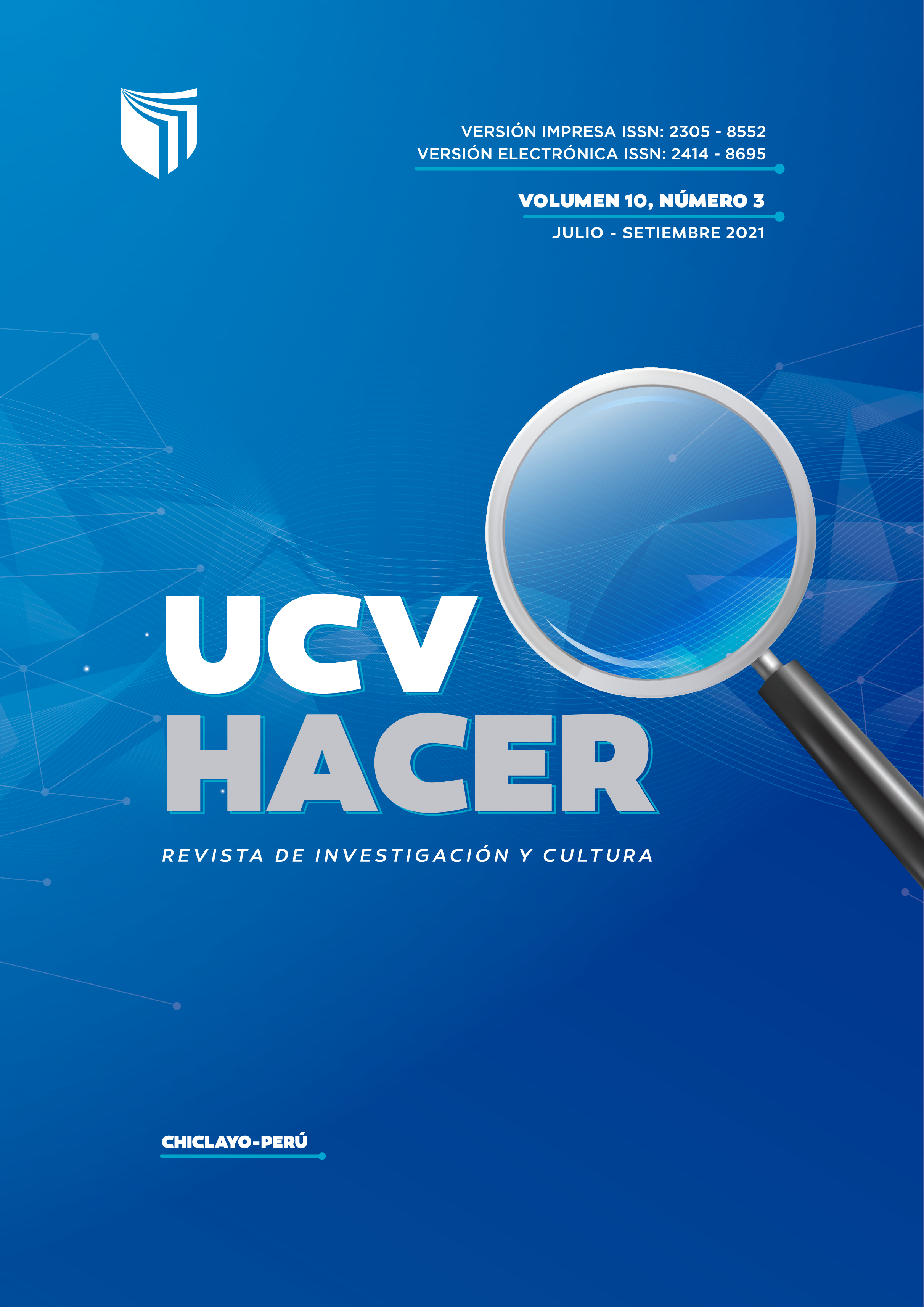Orthotypography to improve the writing of gastronomic and academic texts translated into spanish
DOI:
https://doi.org/10.18050/RevUCVHACER.v10n3a6Keywords:
Program, Orthotypography, TranslationAbstract
This study corresponds to a mixed research perspective, of a propositional type, with the purpose of improving the writing of gastronomic texts in Spanish in students of the curricular experience Direct Translation I of the Universidad César Vallejo, developing aspects that favour the adequate use of the grammatical rules of Spanish and the punctuation marks in the translation of specialized texts. In recent years, a great interest has emerged in research on orthography in relation to translation (Martínez de Sousa, 2004; Veloso, 2004; Claros, 2008). In the theoretical foundation the principles of orthography established by Meneses (2016), the contributions that have referred to communication and the adaptation of uses according to the characteristics of the sender and the client in the translation process are addressed; as well as the orthographic regulations in Spanish. In order to achieve the objectives in this research, a pre-test was created and validated by experts prior to its application. This instrument allowed data collection, its analysis and the discussion of the results. After that, the proposal for the orthographic program in question was designed, accompanied by the corresponding syllabus. Finally, the conclusions and recommendations were established.
Downloads
References
Anguera, M.T. (2003). La observación. En C. Moreno Rosset (Ed.), Evaluación psicológica. Concepto, proceso y aplicación en las áreas del desarrollo y de la inteligencia. Madrid: Sanz y Torres. http://www.observesport.com/desktop/images/docu/gh87qq4t.pdf
Azcárate, W. (2011). La traducción de la estructura del discurso y el posicionamiento del traductor. Núcleo, 23 (28), 33-57. http://ve.scielo.org/scielo.php?script=sci_arttext&pid=S0798-97842011000100002
Bernal, C. (2006). Metodología de la Investigación. México: Pearson Prentice Hall.
Bustos, A. (2013). Manual de acentuación. Lengua-e. 1ra, ed. Cáceres, España. https://www.hispachan.org/hu/src/manual-de-acentuacion.pdf
Cabello, D. (2016). Aproximación a la Ortotipografía Usual y Técnica de la Traducción del inglés al español de los Textos Periodísticos de la sección noticias de The New York Times, 2016 [Trabajo de titulación en Traducción e Interpretación]. http://repositorio.ucv.edu.pe/handle/UCV/3661
Centro de Experimentación Escolar de Pedernales-Sukarrieta (2003). Modelo de programa educativo y evaluación formadora https://www.euskadi.eus/contenidos/informacion/iraunkortasuna_hezkuntza/es_interven/adjuntos/publicaciones/MODELO_DE_PROGRAMA_EDUCATIVO_Y_EVALUACION_FORMADORA.pdf
Claros Díaz, M. G. (2008). Un poco de estilo en la traducción científica: aquello que quieres conocer pero no sabes dónde encontrarlo. Panacea, 9 (28), 145-158. https://www.tremedica.org/wp-content/uploads/n28_revistilo-claros.pdf
Crespo Hidalgo, J. (2002). Cuestiones, problemas y soluciones de ortotipografía, edición y autoedición para autores y traductores. Las herramientas del traductor. https://dialnet.unirioja.es/servlet/articulo?codigo=2479386
Gregorio, A. (2017) Problemas de traducción, detección y descripción: un estudio longitudinal en la formación de traductores. Revista Digital De Investigación en Docencia Universitaria, 11 (02). http://www.scielo.org.pe/pdf/ridu/v11n2/a04v11n2.pdf
Hurtado Albir, A. (2008). Traducción y Traductología. Introducción a la Traductología (1era Ed). Cátedra. Madrid, España.
Jaúregui, R. (2008). El problema de la ortografía. Educere, 12 (42), 625-627. http://ve.scielo.org/scielo.php?script=sci_arttext&pid=S1316-49102008000300023&lng=es&nrm=iso&tlng=es
Martínez de Sousa, J. (2003). Los anglicismos ortotipográficos en la traducción. Panacea. Revista De Medicina, Lenguaje y Traducción –TREMÉDICA, 4 (11). https://www.tremedica.org/wp-content/uploads/n11-editorialsousa.pdf
Martínez de Sousa, J. (2004). La traducción y sus trampas. Panacea. Revista De Medicina, Lenguaje y Traducción –TREMÉDICA, 5 (16). https://www.tremedica.org/wp-content/uploads/n16_tribuna_MartinezDeSousa.pdf
Meneses, M. (2016). Los usos ortotipográficos comparados en los textos gastronómicos franceses y españoles [Trabajo de fin de grado en Traducción e Interpretación]. https://core.ac.uk/download/pdf/75991338.pdf.
Montoro del Arco, E. T. (2011). Análisis de hábitos ortotipográficos del alumnado universitario: ortografía de los elementos tipográficos. Normas. Revista de Estudios Lingüísticos Hispánicos, 1, 113-131. https://dialnet.unirioja.es/servlet/articulo?codigo=4057301
Montoro del Arco, E. T. (2013). Itinerarios para la enseñanza y aprendizaje de la orto(tipo)grafía del español en el sistema ECTS. Comares. Granada, España. https://www.ugr.es/~montoro/pdfs/Montoro_2012_Itinerarios_ortogr.pdf
Nord, C. (2010). Las funciones comunicativas en el proceso de traducción: Un modelo cuatrifuncional. Núcleo, 22 (27), 239-255. http://ve.scielo.org/scielo.php?script=sci_arttext&pid=S0798-97842010000100010
Pérez Martinto, P. C., & Palacios Ladines, L. G. (2014). Un acercamiento al proceso de Investigación Científica. Conceptos, paradigmas y recomendaciones. Chiclayo, Lambayeque, Perú: CENDA, N° 3674-2014. La Habana Cuba.
Real Academia Española. (2010). Ortografía de la lengua española (13ª ed.). Espasa.
Real Academia Española. (2021). Diccionario de la Lengua Española. https://www.rae.es/
Ríos, J. (2009). La traducción deficiente, del inglés al español, de obras teóricas sobre las organizaciones: Un obstáculo al conocimiento. Contaduría y administración, 228, 9-40. http://scielo.unam.mx/scielo.php?pid=S0186-10422009000200002&script=sci_arttext
Robles, P. y Rojas, M. (2015). La validación por juicio de expertos: dos investigaciones cualitativas en Lingüística aplicada. Revista Nebrija de Lingüística aplicada a la Enseñanza de Lenguas, 18, 1-16. https://www.nebrija.com/revista-linguistica/files/articulosPDF/articulo_55002aca89c37.pdf
Rodríguez, F. (2013). Los signos de puntuación en español: cuestiones de uso y errores frecuentes. Boletín de Filología, 48 (1), 147-169. https://scielo.conicyt.cl/scielo.php?script=sci_arttext&pid=S0718-93032013000100007
Rojas, A. (2015). Metodología de Estudio y Escritura Académica. España. E-repositorio de la Universidad de Pompeu Fabra. https://repositori.upf.edu/bitstream/handle/10230/23267/Medea_Tema%207.1.pdf?sequence=1&isAllowed=y
Veloso, I. (2004). Ortotipografía comparada (francés-español). Thélème. Revista Complutense de Estudios Franceses, 19, 183-194. https://revistas.ucm.es/index.php/THEL/article/view/THEL0404110183A
Zaro, J. (2008). Diez estudios sobre la Traducción en la España del siglo XIX. Granada, España: Atrio.
Downloads
Published
Versions
- 2021-12-20 (2)
- 2021-09-20 (1)
How to Cite
Issue
Section
License
Copyright (c) 2021 UCV Hacer

This work is licensed under a Creative Commons Attribution-NonCommercial-ShareAlike 4.0 International License.










